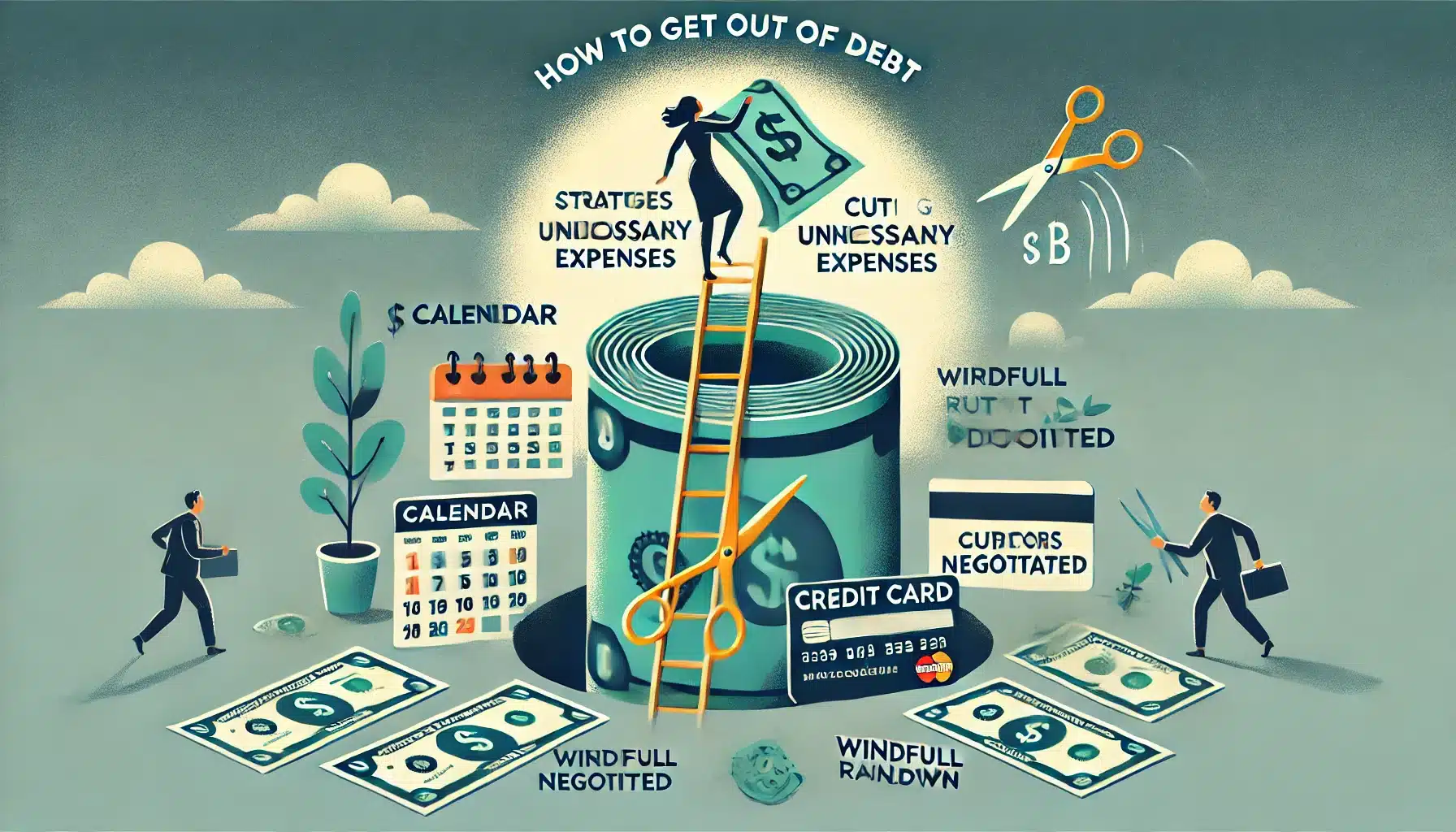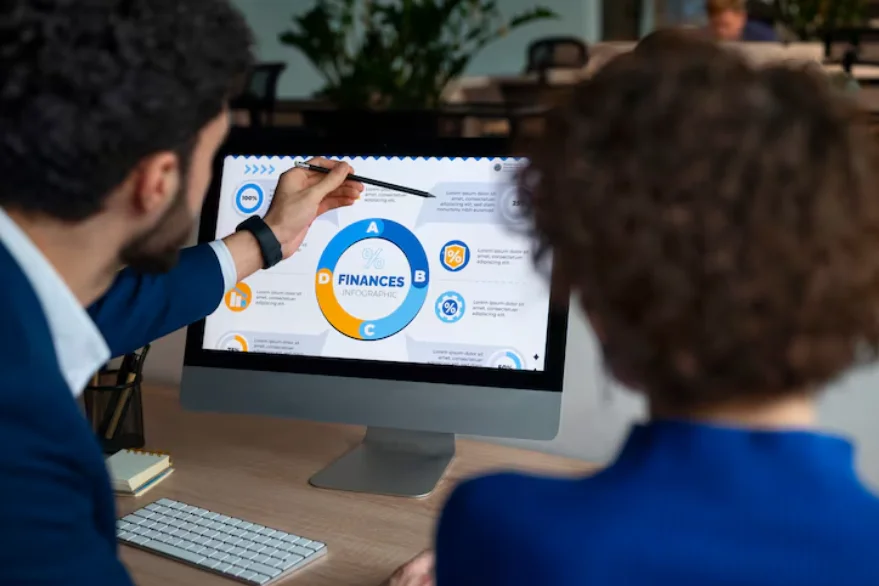How to Get Out of Debt: 10 Proven Strategies for a Debt-Free Future?

Debt can feel like a heavy burden, but it’s possible to get rid of it with the right plan. Whether you’re dealing with credit cards, student loans, or medical bills, becoming debt-free isn’t just a dream. It’s about making small, consistent steps that lead to financial freedom.
This guide will explore proven strategies to help you regain control and build a debt-free future.
Proven Strategies for a Debt-Free Future
Here are some ways to a debt-free future:
1. Evaluate and Organize Your Debts
The first step to solving any problem is understanding it. You can only tackle your debt once you have a clear view of the full picture. Start by listing every debt you owe. This includes all credit cards, loans, medical bills, and personal debts.
Write down the balance, interest rate, and minimum payment for each one. Many people feel overwhelmed because they don’t have all the details. Once you see everything in one place, you’ll have a clearer idea of where to start.
After organizing your debts, take a look at the interest rates. Some debts may be costing you more in interest than others, so understanding which ones are accumulating the most can help prioritize repayment.
Another key to organizing your debt is to identify which are secured (like mortgages or car loans) and which are unsecured (like credit cards). Secured debts can result in loss of assets if not paid, while unsecured debts affect your credit but don’t have collateral tied to them.
Taking these first steps gives you a solid foundation for the journey ahead. Now that you have all your debts laid out, you can develop a plan that fits your financial situation.
2. The Debt Snowball Method
Once you’ve organized your debts, it’s time to choose a repayment strategy. One of the most popular methods is the Debt Snowball Method. This approach focuses on paying off your smallest debts first, giving you quick wins that build momentum. Here’s how it works:
You make the minimum payment on all your debts, except for the smallest one. For that smallest debt, you throw every extra dollar you have at it. Once it’s paid off, you move on to the next smallest debt, rolling over the amount you were paying into that one. With each debt you eliminate, your confidence grows, and you get closer to financial freedom.
This method works because it’s incredibly motivating. Getting rid of a small debt quickly gives you a psychological boost. You see progress, which keeps you on track. It’s easier to stay committed to your debt repayment plan when you see those small wins stacking up. The strategy builds financial discipline, turning paying off debt into a habit.
Though the debt snowball may not save you the most money in the long run (the Debt Avalanche Method does that by focusing on high-interest debts), emotional satisfaction can keep you going when things get tough.
If you’re wondering whether this method works for your situation, remember that it’s particularly helpful for those struggling to stay motivated. The quicker wins help you stick to your debt management plan and eventually snowball your way out of all your debts.
3. The Debt Avalanche Method
If you’re looking to pay off debt in the most cost-effective way possible, the Debt Avalanche Method is your best bet. This strategy focuses on minimizing the amount you spend on interest. While it might not offer the same quick emotional wins as the Debt Snowball Method, it can save you significant money in the long run.
The idea is simple: prioritize paying off debts with the highest interest rates first. Here’s how it works: list all your debts and sort them by interest rate, from highest to lowest. Continue to make minimum payments on all debts, but throw any extra money you have at the debt with the highest interest. Once that debt is paid off, move on to the next one.
This method is especially effective for people with high-interest debts, like credit card balances. By attacking those interest-heavy accounts first, you’re reducing how much money goes toward interest every month. This can lead to substantial savings over time and help you get out of debt faster than you might expect.
While the Debt Avalanche Method requires patience, it’s a smart choice for anyone focused on minimizing total costs rather than quick emotional rewards. It’s a strategy for the long-term planner who wants to maximize savings.
4. Negotiate Lower Interest Rates
Did you know that you can often lower your interest rates just by asking? Many people don’t realize this, but negotiating with your creditors can be a game-changer in your debt repayment plan. Lower interest rates mean less money going toward interest and more going toward the principal balance, which helps you get out of debt faster.
Start by contacting your credit card companies or lenders directly. Explain that you’re working on paying off your debt and ask if they can reduce your interest rate. It helps if you’ve been a good customer with a history of on-time payments. Even a small reduction can save you a significant amount over time.
For example, if you have a high-interest credit card at 20%, getting it reduced to 15% could save hundreds or even thousands of dollars, depending on the balance. Lenders are often willing to negotiate, especially if they believe it will help you avoid default.
If you’re not comfortable negotiating on your own, consider working with a financial advisor or a credit counselor. They can sometimes help you get better terms or guide you through the process. The key is to be proactive. Lowering your interest rates is one of the simplest ways to reduce your overall debt burden.
5. Increase Your Income
When you’re working on getting out of debt, cutting expenses is only half the battle. The other side is increasing your income so you can put more money toward debt repayment. Even small boosts in income can make a big difference.
One of the easiest ways to increase your income is to take on a side hustle. You could do freelance work, deliver groceries, tutor students, or sell handmade products online. With the rise of the gig economy, there are plenty of opportunities to earn extra cash on your schedule.
Another option is to ask for a raise at your current job. If you’ve been performing well and contributing to your company, now might be the time to negotiate for better pay. A raise can provide a long-term income boost, allowing you to accelerate your debt payoff plan.
Finally, selling unused items around your home can bring in quick cash. Look for things you no longer need—like electronics, furniture, or clothes—and sell them online or at local consignment shops. Every extra dollar counts when you’re working to become debt-free.
By increasing your income, you’ll have more resources to allocate toward your debt. Even small income boosts can help you knock out your balances faster, bringing you closer to financial freedom.
6. Consider Debt Consolidation
Debt consolidation is a smart strategy if you’re juggling multiple debts with varying interest rates and payment schedules. Essentially, debt consolidation allows you to combine all your debts into one loan or credit line, ideally at a lower interest rate. This can simplify your monthly payments and reduce the total amount of interest you pay over time.
There are several options to consider for debt consolidation. You can use a personal loan, transfer your balances to a low-interest credit card, or even take out a home equity loan if you’re a homeowner. Each method has its benefits and risks, so it’s important to evaluate which one works best for your financial situation.
While debt consolidation won’t eliminate your debt, it can make managing it much easier and less stressful. Just remember, consolidating debt works best when paired with disciplined spending and a commitment to paying off what you owe. Without that, you could end up in a worse position than before.
7. Cut Unnecessary Expenses
One of the most effective ways to free up money for debt repayment is by cutting unnecessary expenses. Most of us have areas in our budget where we can trim the fat. The key is to find and eliminate those small, regular expenses that add up over time.
Start by reviewing your subscriptions. Do you need multiple streaming services or that monthly subscription box? Even cutting out one or two of these can free up extra cash. Also, take a look at your dining-out habits. Cooking at home more often can save you hundreds of dollars a month.
Another area where you can cut costs is transportation. If you have multiple cars, consider selling one, or using public transportation when possible. Little changes like carpooling or combining errands can reduce fuel expenses significantly.
By cutting unnecessary expenses, you’ll free up more money that can go directly to paying off your debt. It’s one of the quickest ways to find extra cash in your budget and speed up your journey to becoming debt-free.
8. Seek Professional Help
If you feel overwhelmed by your debt and don’t know where to start, it might be time to seek professional help. Financial advisors, credit counselors, and debt relief specialists can provide guidance on the best strategies for your unique situation. They can also negotiate with creditors on your behalf to reduce interest rates or set up more manageable payment plans.
Credit counseling agencies can help you develop a debt management plan, which consolidates your debts into a single payment while negotiating better terms with your creditors. These services are often free or low-cost and can be a great resource for those struggling to manage their debts on their own.
In more extreme cases, consulting with a bankruptcy lawyer might be necessary. Bankruptcy should be a last resort, but for some people, it’s the best way to get a fresh financial start. A professional can help you evaluate your options and decide the best course of action to get out of debt for good.
Seeking help isn’t a sign of failure—it’s a smart step towards regaining control of your finances. The right guidance can make all the difference in how quickly you’re able to move towards a debt-free future.
9. Take Advantage of Windfalls
Windfalls are those unexpected financial gains that can significantly speed up your debt repayment. These might include tax refunds, bonuses from work, or even gifts from family. While the temptation to splurge can be strong, using these unexpected funds to pay off debt is one of the smartest decisions you can make.
Whenever you receive a windfall, consider putting it directly towards your highest-interest debt or the debt that’s closest to being paid off. This approach not only helps reduce your overall debt but also saves you from paying more interest in the future. Even a few hundred dollars can make a big difference when applied strategically. If possible, plan ahead for annual windfalls, like tax refunds, and earmark them for debt repayment.
By using windfalls wisely, you can make significant progress toward becoming debt-free faster than you may have thought possible.
10. Government Assistance Programs
If you’re struggling with debt, don’t overlook the possibility of government assistance. There are several programs designed to help low-income individuals and families with essential expenses, freeing up more of your income to tackle your debt.
Programs like the Supplemental Nutrition Assistance Program (SNAP), which provides food assistance, or the Low Income Home Energy Assistance Program (LIHEAP), which helps with utility bills, can relieve some of your financial burdens. This allows you to reallocate more of your income towards paying off your debts. Other programs, like Medicaid and the Children’s Health Insurance Program (CHIP), help with medical expenses, another area where costs can pile up and contribute to debt.
Take the time to explore what government programs you might qualify for. Even small forms of assistance can create breathing room in your budget, making it easier to get ahead in your debt repayment plan.
Conclusion
Getting out of debt isn’t easy, but with the right strategies, it’s entirely possible. By organizing your debts, choosing a repayment method like the debt snowball or avalanche, negotiating lower interest rates, and cutting unnecessary expenses, you can make significant progress.
Additionally, increasing your income, seeking professional help when needed, and taking advantage of windfalls and government assistance programs will put you on a faster path to financial freedom.
The key is to stay committed and consistent. Every step you take, no matter how small, brings you closer to a debt-free future. Keep your eyes on the goal, and with persistence, you’ll find yourself free from the burden of debt, ready to enjoy a more secure financial future.

Strategic Marketing Solutions for Modern Businesses

How Traffic Management Businesses Are Improving Field Accountability

How to Plan a Last-Minute Holiday Trip with Instant Loan Support

How to Spot a Well-Made Furniture Piece When You’re Not an Expert

Metz for Hair Grooming: A Look at Its Catalog

How CPAs Support Cost Reduction And Profitability Goals

Why Tax Accountants Remain Indispensable In A Digital World

Why Accounting Firms Are Key Partners During Business Mergers








